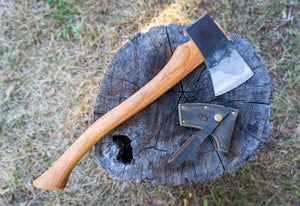
Care for Your Blade: How to Sharpen Pocket Knives in 6 Steps
Carrying a pocket knife is like keeping a trusty friend by your side. It will help you get out of scrapes and through hard days. Store it in your pocket, purse or truck, and bring it out when you need help with the little things.
A pocket knife is used to cut rope, bailing twine or tape on birthday presents. It can also be used to whittle or open letters. If you’re a hunter, a sharp pocket knife comes in handy for skinning game.
Once you’ve chosen your pocket knife and put it to work, you’ll need to care for its blade to extend its lifespan. A blade must be honed and maintained. A dull blade makes for a useless—and potentially dangerous—knife. In this article, we share step-by-step instructions on how to sharpen pocket knives.
Start caring for your Case, Benchmade or Browning knife today!
Jump to:
- Step 1: Gather Supplies
- Step 2: Clean Knife
- Step 3: Mark Edge
- Step 4: Add Lubricant
- Step 5: Sharpen Knife
- Step 6: Test Blade
Step 1: Gather Supplies
Not all knives are created equal—and neither are all sharpeners. The first step to learning how to sharpen knives is obtaining the right tools. To find the best pocket knife sharpener for your blade, refer to the manufacturing information or manual that came with the knife upon purchase.
There are different options for sharpeners, including whetstones, steels or pull-through sharpeners, and you should choose what you are most comfortable with. Whatever you choose, always sharpen with the coarser-grit sharpener first and work toward the finer-grit stone or sharpener.
Whetstones
These natural sharpening stones act like sand and come in various grits, which identify how abrasive they are. Using a whetstone takes practice since you must find and maintain the exact angle of your blade.
Whetstones also require water or oil, depending on the type. Before sharpening, you must submerge the stone in water or lubricant.
Steels
Steel is a hard material. When sharpening with steel, you’ll see more metal shed from your knife than when using a whetstone. Steel knife sharpeners can be tricky to handle. While a whetstone sits on a level surface, steel sharpeners are often handheld, meaning you have to hold the knife with one hand and the sharpener with the other.
Pull-throughs
If you’re looking for a fast way to sharpen knives, you should explore pull-through sharpeners. They won’t give you the precision of sharpening on a whetstone, and you’ll shed a lot of your blade’s metal. However, they are easy to use. Pull your knife through the sharpener’s slots, and you’re done!
Step 2: Clean Knife
You want to sharpen a clean knife. Debris or rust will prevent you from getting a super-sharp edge. Before you begin, wash your knife with soap and water. You can scrub it with a sponge or a toothbrush.
For rusty knives, grab the WD-40 and use a pad or towel to remove the rust.
Step 3: Mark Edge
Once your knife is clean, it’s time to mark it! We recommend marking the edge of your blade with a marker before sharpening your knives. Take a marker and draw along the edge. The mark will help you see the angle of your blade.
Pocket knives are often sharpened at 15- to 20-degree angles. Always check with the manufacturer for the precise angle of the blade. You should sharpen at the blade's current angle unless you are aiming to reprofile the blade entirely.
As you sharpen, the mark you made will indicate how long you should continue honing each side. With each stroke, you will remove bits of the mark. Once you can no longer see the mark you made, you should check for burrs on the blade.
Step 4: Add Lubricant
As you sharpen your blade, you’ll generate heat and create swarf (metal shavings). Too much heat could warp your blade. Lubricants, like water or oil, help reduce the heat produced and the amount of swarf created from the process.
Step 5: Sharpen Knife
Now for the fun part! Let’s say you’re using a whetstone to sharpen a pocket knife. You want to start with the coarser-grit stone first. You can use a back-and-forth, circular or downward slicing motion—whatever you are comfortable with.
Initial Steps
- Read the directions that came with your knife.
- Place the knife on the dampened stone.
- Make back-and-forth motions with your pocket knife on the stone. Be sure to angle your knife at the appropriate degree, and never hold your blade completely flat against the stone. You don’t need to apply a lot of pressure for this step.
- Wipe excess oil or water off the stone between passes.
- Count the number of times you do this.
- Repeat steps two through four on the opposite side of the blade.
- Check the edge to see if your mark is gone.
- Check for burr on the edge. You can use a piece of paper to test how the knife cuts. If it cuts smoothly down the paper, you have no burr. If it catches along the edge, you have more work to do!
Refining Your Blade
Once any burr is gone, you can begin refining your blade. Remember to keep your angle consistent.
- Choose and wet a finer-grit stone.
- Switch to one-directional passes across the stone, like you’re trying to slice a thin part of it. Make these passes go away from your body. Remember to let the stone do the work—you don’t need to apply heavy pressure to the knife.
- Count the number of passes you make. Try for 10 passes before feeling the edge of the blade.
- Repeat step two on the opposite side for the same number of passes.
- Continue this process until the edge feels the same on both sides.
Sharpening your pocket knives may initially be a big time commitment. If you maintain the blades regularly, a few strokes across a stone will keep them sharp. Once you get in the habit of sharpening your knives, it will go faster! Some people enjoy the meditative practice of caring for their knives.
Step 6: Test Blade
When you’re ready to check your blade, wipe the pocket knife with a clean cloth and look at its edge. In the sun or under a light, a dull cutting edge will reflect the light and be shiny. A sharp blade edge won’t shine because it’s too thin to reflect light.
You should also try the paper slice test once more. If the blade runs smoothly down a piece of paper, you have sharpened it well, and it’s ready for use.
Grab A New Pocket Knife at Crane’s Country Store
“I have too many knives.”
Said no one ever…
If you need another knife or a great pocket knife sharpener, Crane’s Country Store carries reputable pocket knife brands. Find your next knife in our collection of Case, Benchmade and Browning knives.
You can order online or visit our store near Columbia, MO, to test our pocket knives in person. Remember—once you purchase a knife, sharpen it regularly!
Save this article for later when it’s time to refine your blade.









